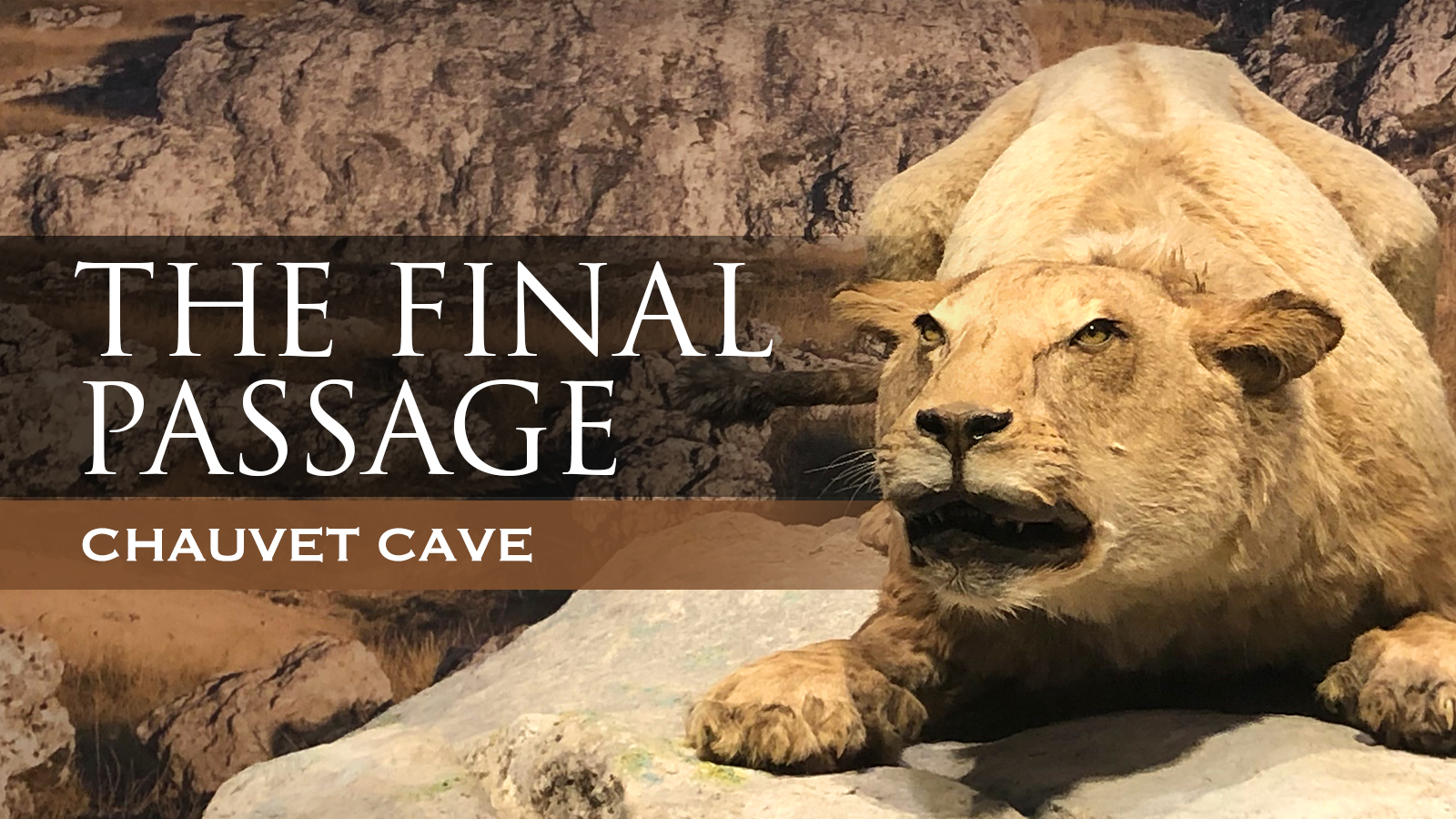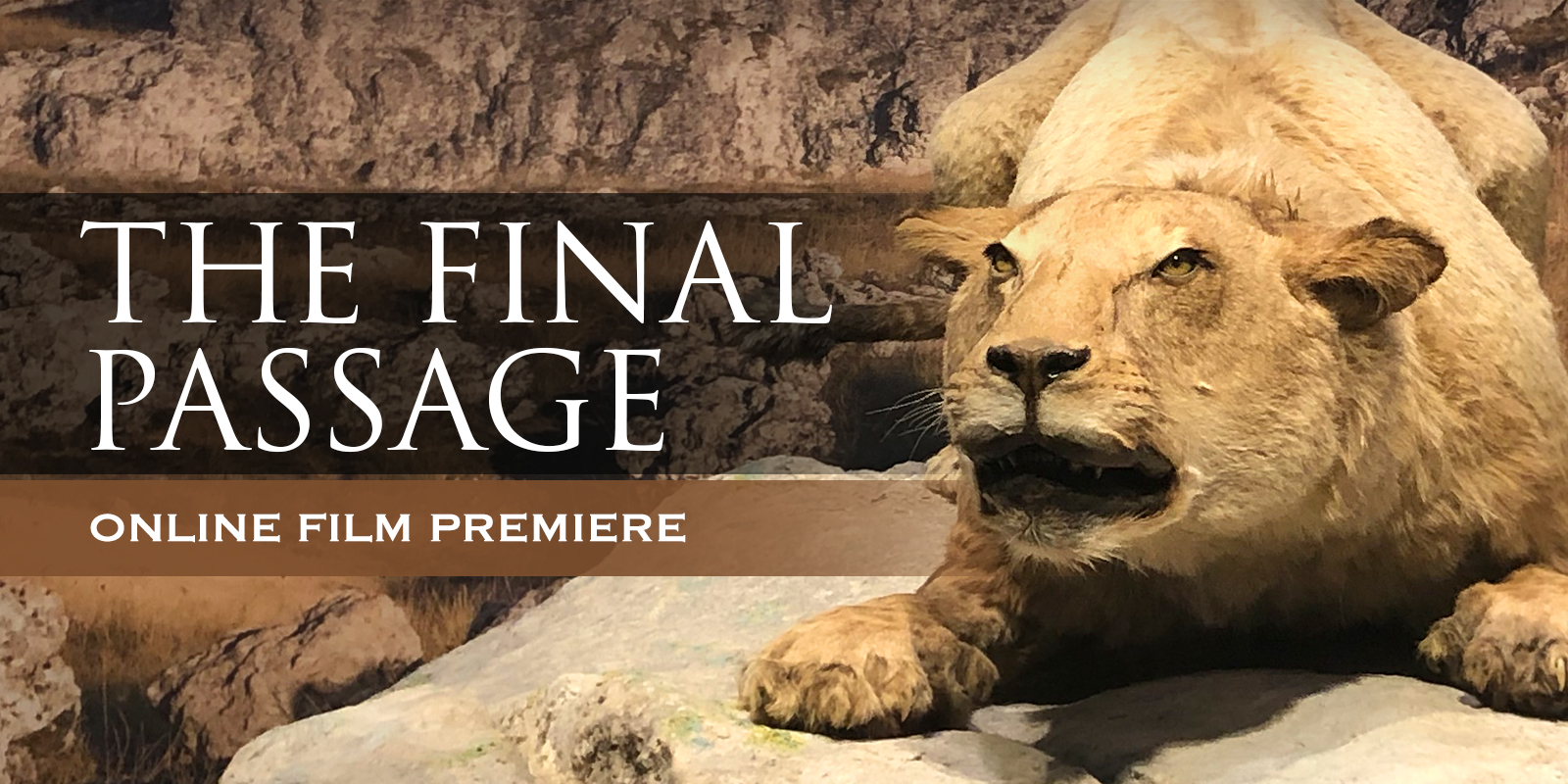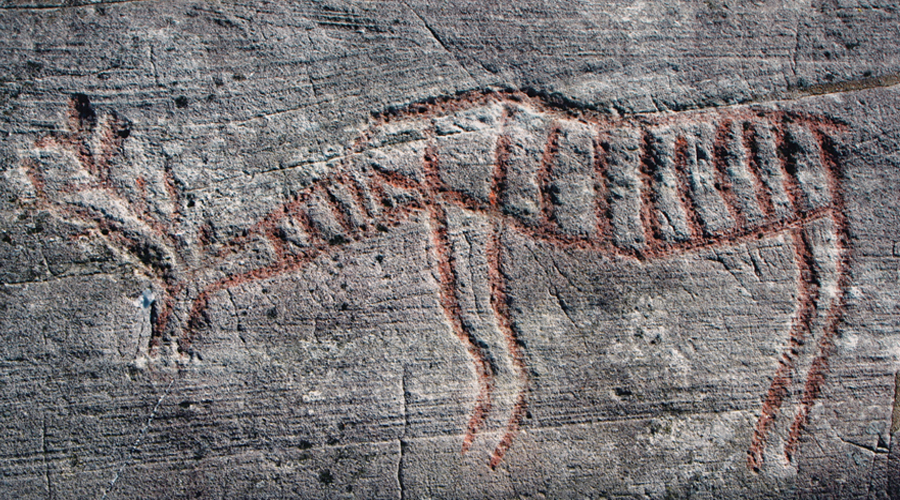


by Jean-Michel Geneste
Former Director, National Center for Prehistory, Ministry of Culture and Communication, France
Due to the great fragility of the cave, very few people are allowed to work inside it. For example, the archaeologists work in the cave for only three weeks per year, with a maximum of 12 persons per day. Filming the cave with traditional methods and a full crew was thus out of the question. Over several years, we thus made a digital model of the cave with laser scanners and took tens of thousands of high-definition photographs. We then composed “The Final Passage” film from this virtual model and photographs of the cave.
The artists of Chauvet Cave used a great diversity of techniques to create its equally diverse artworks, ranging from monumental to very discrete. It is thus certain that many artists with varied and distinct skills participated in this endeavor. We can distinguish prodigious artists who mastered form, color, and figurative rendering on the rock walls from others who drew simple, less visible, or even invisible, images. All these artists nonetheless adhered to same rules in their depictions of animals, humans, and geometric signs, and we can thus see that they shared the same culture and skills but not the same experience in creating art on cave walls. While there is, therefore, no reason to believe that all the artists were specialists, those who created the masterpieces certainly were, and they existed alongside the specialized flint knappers of this time, 36,000 years ago.
Due to the difficulty of accessing it and the symbolic meaning likely attributed to such a place, the art deep in caves, such as Chauvet, was probably meant to be seen by everyone, as well as for ritual activities. We must also remember that Paleolithic people made art on rock surfaces outside of caves as well, where it was visible to all, along the with engravings, sculptures and ornaments they made on bone, stone and shells that were part of their daily lives, and which they shared and exchanged among themselves. For them, like for us, art thus had many different meanings and functions in their society.
The Paleolithic artists and other visitors to the cave used torches and lit many fires on ground. Given the numerous charcoal fragments scattered across the cave floor, we can deduct that many fires were intentionally located near the art panels, some of which were even burned by the heat emanating from these fires, but not too much heat, to avoid filling the cave with smoke. They used resinous wood, mostly pine.
Though there are many rhinoceroses depicted in the cave, they are not all identical. Their morphology varies, as does the size and shape of their horns. We can thus distinguish between males and females. The two rhinoceroses of the Panel of the Horses are facing each other, and since this art respects animal behaviors while also being symbolic, this could represent a charging battle between two males during the rutting season.
That’s a good question, for which we’ll never have a certain answer because the artists are no longer here to tell us. But such depictions do tell us something very important, which is that this art is symbolic. A symbol is something that represents or stands for something else, like a diamond ring represents a wedding engagement. Because striped rhinoceroses don’t exist in the real world, we know that the stripe had a meaning for the artists and their community, which could be understood only by those to whom that meaning was transmitted. Symbolic communication is unique to humans and prehistoric art shows us that our ancestors already had this complex intellectual capacity at least 100,000 years ago.
There are no human depictions in the manner that we tend to think of them today. There are, however, depictions of human body parts, such as pubic triangles. We do not see these engraved female genitalia in the film. Toward the end of the cave, at the very end of the film, we discover, on an elegant rock pendant, a composite representation associating the lower half of a woman’s body intertwined with a bison and another animal that is probably a lion.
Hunting scenes are rare in cave art and Paleolithic art in general. It is not until around 25,000 years ago that we see animals in association with arrows, such as at Lascaux. But are these really hunting scenes? Hunting was a predatory activity implying significant responsibility and the interaction between the living and their representation probably adhered to strict norms. Hunting as such was therefore of a sacred nature very rarely represented.
The animals represented are not always those that were eaten. Indeed, were mammoths, lions and rhinoceroses really “consumable”? These species were probably considered as symbols in the depiction of explanatory, religious or mythic histories and stories. We thus sense a great deal of empathy in these modes of animal depiction and can indeed perceive a respectful, or even appreciative, relationship between the artists and their models.
We regularly discover decorated caves in the regions where they are naturally concentrated, such as southwestern France and Cantabria in Spain, as well as in Africa, Australia and Indonesia. Many caves remain to be discovered.
When wood charcoal is burned at a very high temperature, it is transformed into fossil carbon. Carbon is rather stable and can be preserved for a very long time if it is not crushed and thus mechanically destroyed. Due to its excellent preservation, Paleolithic artists could use it as a black pigment and, using the Carbon14 method, scientists today can date it up to at least 50,000 years ago.
The only wood used in Chauvet Cave is Black Pine (Pinus nigra). This resinous species was common at the time and easy to light. To light fires during this period when there were no lighters or matches, humans either saved coals in a container for future use, or made fire by friction, which is easy to do with dry wood.
Paleolithic people did not live in caves, or very rarely at most. They lived outside where there was sunlight and warmth. Life in a cave is too difficult. Around Chauvet cave, we thus find their dwelling sites in the valley or on the Ardèche plateaus. They often lived in camps in the open-air, or in the sheltered entrances of caves. Some of the sites already discovered and excavated in the region are documented and presented at the regional prehistory museum of Orgnac l’Aven in Ardèche (https://www.orgnac.com/en/)
On some panels, in chambers deep in the cave and thus completely confined for a long time, the first few millimeters of the surface of the limestone walls is altered. The artists superficially scraped this soft, brownish layer to expose the lighter colored and more consistent surfaces below. They were able to draw on these newly exposed surfaces with their fingers or with black charcoal. We see this process very well in the film if we watch attentively.
Walking at an average pace of one meter per second, it takes 28 minutes to walk from the cave entrance to the End Chamber. The film this also lasts 28 minutes.
Because the cave is deeply buried within the limestone cliff and its entrance was closed for 21,000 years, the temperature inside is around 12 degrees Celsius throughout the year. It is also humid. The area near the entrance is dryer than the deepest parts, where water puddles can accumulate after rainy periods.
Though none have been discovered in Chauvet Cave, they have in other caves. These artifacts consist mostly of bird bone flutes with two, three, or even four holes. Stalagmites were used as lithophones in some caves but not at Chauvet, as least as far as we currently know. Future research may reveal new surprises.
Chauvet Cave is quite long, extending along 400 meters, and there are thus tens of thousands of square meters of untouched walls. The artists in various periods used only the panels that were appropriate to their objectives at the time. Their choices could have been influenced by factors such as the location, the nature of the limestone surface, the shape of the chamber, or the size and morphology of the panels. This immense cave, like many others, was decorated for precise reasons. There are other caves, several kilometers long, which were decorated only in the first 200 or 300 meters, for example.
→ For more information and to watch The Final Passage, please visit: www.taraexpo.com
→ Members and affiliated institutions of the Rock Art Network
by
George Nash
5/09/2024 Recent Articles
→ Sigubudu: Paintings of people with guns in the northern uKhahlamba-Drakensberg
by Aron Mazel
22/07/2024
by Richard Kuba
13/06/2024
by Meenakshi Dubey-Pathak
8/03/2024
by Rock Art Network
6/02/2024
by Rock Art Network
14/12/2023
by Sam Challis
5/12/2023
by Aron Mazel
30/11/2023
by Sam Challis
21/11/2023
by Sam Challis
15/11/2023
by Sam Challis
10/11/2023
by Rock Art Network
6/11/2023
by Rock Art Network
3/11/2023
by Aron Mazel
2/11/2023
by Meenakshi Dubey-Pathak
26/09/2023
by Paul Taçon
24/08/2023
by Aron Mazel
13/06/2023
by Paul Taçon
5/06/2023
by Paul Taçon
15/03/2023
by George Nash
14/03/2023
by Noel Hidalgo Tan
10/02/2023
by George Nash
01/02/2023
by Meenakshi Dubey-Pathak, Pilar Fatás Monforte
29/11/2022
by Aron Mazel, George Nash
21/09/2022
by Paul S.C. Taçon, Sally K. May, Ursula K. Frederick, Jo McDonald
07/07/2022
by Meenakshi Dubey-Pathak
26/07/2022
by Paul Taçon
20/07/2022
by David Coulson
16 June 2022
by Paul Taçon
25 April 2022
by Noel Hidalgo Tan
20 April 2022
by Meenakshi Dubey-Pathak
14 March 2022
by Carolyn Boyd & Pilar Fatás
02 March 2022
by David Coulson
07 February 2022
by Johannes H. N. Loubser
06 February 2022
by Meenakshi Dubey-Pathak
05 February 2022
by Aron Mazel
28 January 2022
by Aron Mazel
8 September 2021
by David Coulson
17 August 2021
by Ffion Reynolds
21 June 2021


by Aron Mazel
22/07/2024
by Richard Kuba
13/06/2024
by Meenakshi Dubey-Pathak
8/03/2024
by Rock Art Network
6/02/2024
by Rock Art Network
14/12/2023
by Sam Challis
5/12/2023
by Aron Mazel
30/11/2023
by Sam Challis
21/11/2023
by Sam Challis
15/11/2023
by Sam Challis
10/11/2023
by Rock Art Network
6/11/2023
by Rock Art Network
3/11/2023
by Aron Mazel
2/11/2023
by Meenakshi Dubey-Pathak
26/09/2023
by Paul Taçon
24/08/2023
by Aron Mazel
13/06/2023
by Paul Taçon
5/06/2023
by Paul Taçon
15/03/2023
by George Nash
14/03/2023
by Noel Hidalgo Tan
10/02/2023
by George Nash
01/02/2023
by Meenakshi Dubey-Pathak, Pilar Fatás Monforte
29/11/2022
by Aron Mazel, George Nash
21/09/2022
by Paul S.C. Taçon, Sally K. May, Ursula K. Frederick, Jo McDonald
07/07/2022
by Meenakshi Dubey-Pathak
26/07/2022
by Paul Taçon
20/07/2022
by David Coulson
16 June 2022
by Paul Taçon
25 April 2022
by Noel Hidalgo Tan
20 April 2022
by Meenakshi Dubey-Pathak
14 March 2022
by Carolyn Boyd & Pilar Fatás
02 March 2022
by David Coulson
07 February 2022
by Johannes H. N. Loubser
06 February 2022
by Meenakshi Dubey-Pathak
05 February 2022
by Aron Mazel
28 January 2022
by Aron Mazel
8 September 2021
by David Coulson
17 August 2021
by Ffion Reynolds
21 June 2021
Friend of the Foundation


by Aron Mazel
22/07/2024
by Richard Kuba
13/06/2024
by Meenakshi Dubey-Pathak
8/03/2024
by Rock Art Network
6/02/2024
by Rock Art Network
14/12/2023
by Sam Challis
5/12/2023
by Aron Mazel
30/11/2023
by Sam Challis
21/11/2023
by Sam Challis
15/11/2023
by Sam Challis
10/11/2023
by Rock Art Network
6/11/2023
by Rock Art Network
3/11/2023
by Aron Mazel
2/11/2023
by Meenakshi Dubey-Pathak
26/09/2023
by Paul Taçon
24/08/2023
by Aron Mazel
13/06/2023
by Paul Taçon
5/06/2023
by Paul Taçon
15/03/2023
by George Nash
14/03/2023
by Noel Hidalgo Tan
10/02/2023
by George Nash
01/02/2023
by Meenakshi Dubey-Pathak, Pilar Fatás Monforte
29/11/2022
by Aron Mazel, George Nash
21/09/2022
by Paul S.C. Taçon, Sally K. May, Ursula K. Frederick, Jo McDonald
07/07/2022
by Meenakshi Dubey-Pathak
26/07/2022
by Paul Taçon
20/07/2022
by David Coulson
16 June 2022
by Paul Taçon
25 April 2022
by Noel Hidalgo Tan
20 April 2022
by Meenakshi Dubey-Pathak
14 March 2022
by Carolyn Boyd & Pilar Fatás
02 March 2022
by David Coulson
07 February 2022
by Johannes H. N. Loubser
06 February 2022
by Meenakshi Dubey-Pathak
05 February 2022
by Aron Mazel
28 January 2022
by Aron Mazel
8 September 2021
by David Coulson
17 August 2021
by Ffion Reynolds
21 June 2021
Friend of the Foundation















